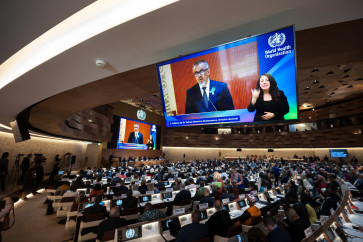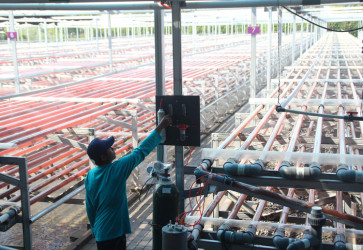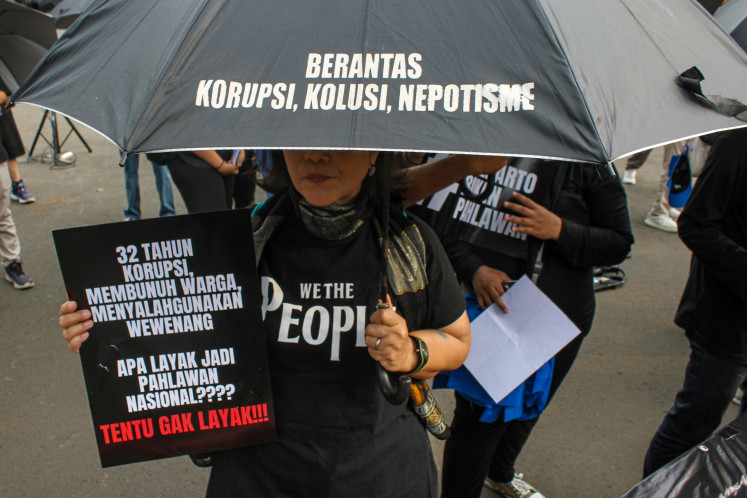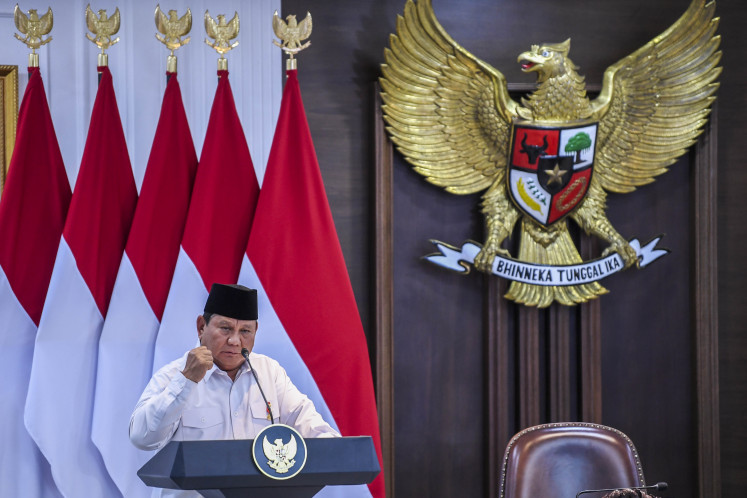[ANALYSIS] Why is Indonesia so slow in transitioning to renewable energy?
High investment needed for renewable energy power plants has hampered the transition from fossil fuels to renewables.
Change text size
Gift Premium Articles
to Anyone
![[ANALYSIS] Why is Indonesia so slow in transitioning to renewable energy?](https://img.jakpost.net/c/2020/01/20/2020_01_20_84887_1579498326._large.jpg)
R
enewable sources are still not the main choice for energy in Indonesia. Coal still dominates in the energy mix for electricity, accounting for 66.3 percent of the total power generated in 2019. Meanwhile, renewable energy only contributed 15.6 percent in 2019, decreasing slightly from 16 percent in 2018. However, electricity generated from renewable energy sources increased significantly in the 2015-2019 period.
According to the Energy Balance report published by the Energy and Mineral Resources Ministry, the consumption of renewable energy in the electricity sector in 2019 reached 97.1 million barrels of oil equivalent (BOE), an increase of 64.9 million BOE compared to 2015. However, this increase was still lower than the increase of energy originating from coal, which reached 119.6 million BOE in the same period.
Why is Indonesia relatively sluggish in shifting to renewable energy? The foremost reason is that renewable energy power plants are more expensive than fossil-fuel power plants.
According to the Indonesian Private Power Producers Association (APLSI), renewable energy plants in Indonesia require relatively high investment at around US$2 million to $3 million per megawatt for hydropower, $2.5 million to $6 million per MW for geothermal and $1.5 million to $2.9 million per MW for photovoltaic facilities. Meanwhile, the cost of fossil fuel-based power plants is only between $1.5 million to $1.7 million per MW for coal, $1.1 million to $1.7 million per MW for oil, and $1.5 million to $1. 8 million per MW for gas.
The consequence of this is that investors in renewable energy power plants require a higher electricity selling price than those building fossil-fuel-based power plants. Meanwhile, Energy and Mineral Resource Ministry Regulation No. 50/2017 states that the selling price of electricity from renewable energy to state-owned electricity firm PLN must be lower than PLN’s production cost. Currently, PLN mostly uses coal-fired power plants that are cheaper than renewable energy power plants. As a result, PLN’s purchase price for electricity from renewable energy power plants is not attractive to investors.
Currently, the government is drafting new regulations on the electricity purchase price from renewable energy power plants to make investment in such plants more attractive to investors. However, implementing the regulation could have undesirable consequences for the state. Selling electricity generated from renewable sources to PLN at a higher price will increase PLN's production cost, which will ultimately increase the government’s electricity subsidy.
Will the government be able to bear the increase in the electricity subsidy? If the government is unable to bear the cost, it will increase electricity prices for consumers.
Under these circumstances, the government could opt for several policy alternatives to accelerate the use of renewable energy.
First, Indonesia should take advantage of cheap funding offered by developed countries to build renewable energy power plants. Climate change is a global issue that requires cooperation between developed and developing countries. It is appropriate for developed countries to help developing countries facilitate renewable energy power plant investment through cheap funding. The opportunity to get funding is also more open with global investors’ increasing interests in sustainable or green bonds. Moody expects sustainable bond issuance in 2021 to reach a new record of $650 billion, increasing by 32 percent from the 2020 issuance.
Second, the government needs to accelerate carbon trading between power plants at the domestic level. With this scheme, power plants that generate electricity more efficiently and with minimal emissions will get financial benefits. Conversely, power plants that have more emissions will receive a disincentive through the obligation to buy carbon credits from the more efficient power plant. Also, Indonesia should take advantage of carbon credits it gets from maintaining its forests. Indonesia can use the financial benefits to build renewable energy power plants. While the government cannot add extra burden to the state budget to subsidize renewable energy, this scheme will provide added incentives to develop renewable energy power plants.
Lastly, the government should continue energy subsidy reform to change the scheme from providing a subsidy to the commodity (electricity) to giving the subsidy directly to the consumers. With such a targeted subsidy scheme, the government would not be burdened by a potential increase in electricity production costs as we shift to renewable energy. Moreover, as richer households tend to consume more energy than poor households, the current electricity subsidy is inefficient if its purpose is to support the poorest households.
Indonesia must continue to accelerate the use of renewable energy in the future. In the long run, along with technological advances, building renewable energy power plants will be cheaper. The characteristic of renewable energy power plants with large initial investment costs but low variable costs will benefit the economy in the long run.
Of course, we do not want to repeat the mistakes of Indonesia's energy policies that delayed the energy transition from oil to coal so that Indonesia's energy costs are higher than in other countries. Besides, renewable energy will ensure the availability of energy in the long run. Fossil-fuel energy sources, such as petroleum, natural gas and coal, are limited and will be depleted in the future.
***
Industry analyst at Bank Mandiri









